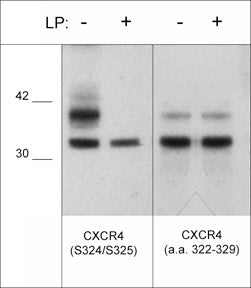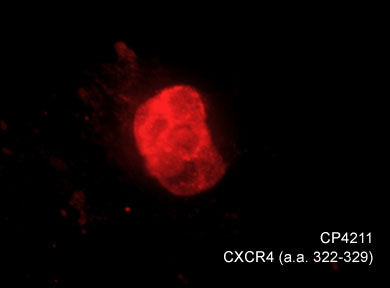Anti-CXCR4 (C-terminal region) Antibody
- SPECIFICATION
- CITATIONS
- PROTOCOLS
- BACKGROUND

Application
| WB |
|---|---|
| Primary Accession | P61073 |
| Reactivity | Bovine, Chicken |
| Host | Rabbit |
| Clonality | Rabbit Polyclonal |
| Isotype | IgG |
| Calculated MW | 39746 Da |
| Gene ID | 7852 |
|---|---|
| Other Names | FB22; HM89; LAP3; LCR1; NPYR; WHIM; CD184; LESTR; NPY3R; NPYRL; HSY3RR; NPYY3R; D2S201E; CXCR4 |
| Target/Specificity | The chemokine receptor CXCR4 is a widely expressed G protein-coupled receptor required for development, hematopoiesis, organogenesis, and vascularization. In disease, CXCR4 has been implicated in WHIM syndrome, HIV, and cancers. Regulation of CXCR4 function occurs through phosphorylation at multiple sites in the C-terminal region. These sites have been shown to be phosphorylated after CXCL12 stimulation, and involve several kinases, such as PKC and GRK kinases. After CXCL12 stimulation of HEK293 cells, Ser-324 and Ser-325 become phosphorylated by PKC and GRK6, while Ser-330 and Ser-339 are phosphorylated by only GRK6. In human astroglia cells, Ser-324 and Ser-325 are rapidly phosphorylated in endogenous CXCR4, while Ser-330 was phosphorylated with slower kinetics. In addition, arrestin binding to CXCR4 is driven by this phosphorylation of far C-terminal residues. Thus, site-specific phosphorylation of CXCR4 may be regulated by multiple kinases lead to complex regulation of CXCR4 signaling. |
| Dilution | WB~~1:1000 |
| Format | Antigen Affinity Purified |
| Storage | Maintain refrigerated at 2-8°C for up to 6 months. For long term storage store at -20°C in small aliquots to prevent freeze-thaw cycles. |
| Precautions | Anti-CXCR4 (C-terminal region) Antibody is for research use only and not for use in diagnostic or therapeutic procedures. |
| Shipping | Blue Ice |

Thousands of laboratories across the world have published research that depended on the performance of antibodies from Abcepta to advance their research. Check out links to articles that cite our products in major peer-reviewed journals, organized by research category.
info@abcepta.com, and receive a free "I Love Antibodies" mug.
Provided below are standard protocols that you may find useful for product applications.
Background
The chemokine receptor CXCR4 is a widely expressed G protein-coupled receptor required for development, hematopoiesis, organogenesis, and vascularization. In disease, CXCR4 has been implicated in WHIM syndrome, HIV, and cancers. Regulation of CXCR4 function occurs through phosphorylation at multiple sites in the C-terminal region. These sites have been shown to be phosphorylated after CXCL12 stimulation, and involve several kinases, such as PKC and GRK kinases. After CXCL12 stimulation of HEK293 cells, Ser-324 and Ser-325 become phosphorylated by PKC and GRK6, while Ser-330 and Ser-339 are phosphorylated by only GRK6. In human astroglia cells, Ser-324 and Ser-325 are rapidly phosphorylated in endogenous CXCR4, while Ser-330 was phosphorylated with slower kinetics. In addition, arrestin binding to CXCR4 is driven by this phosphorylation of far C-terminal residues. Thus, site-specific phosphorylation of CXCR4 may be regulated by multiple kinases lead to complex regulation of CXCR4 signaling.
If you have used an Abcepta product and would like to share how it has performed, please click on the "Submit Review" button and provide the requested information. Our staff will examine and post your review and contact you if needed.
If you have any additional inquiries please email technical services at tech@abcepta.com.













 Foundational characteristics of cancer include proliferation, angiogenesis, migration, evasion of apoptosis, and cellular immortality. Find key markers for these cellular processes and antibodies to detect them.
Foundational characteristics of cancer include proliferation, angiogenesis, migration, evasion of apoptosis, and cellular immortality. Find key markers for these cellular processes and antibodies to detect them. The SUMOplot™ Analysis Program predicts and scores sumoylation sites in your protein. SUMOylation is a post-translational modification involved in various cellular processes, such as nuclear-cytosolic transport, transcriptional regulation, apoptosis, protein stability, response to stress, and progression through the cell cycle.
The SUMOplot™ Analysis Program predicts and scores sumoylation sites in your protein. SUMOylation is a post-translational modification involved in various cellular processes, such as nuclear-cytosolic transport, transcriptional regulation, apoptosis, protein stability, response to stress, and progression through the cell cycle. The Autophagy Receptor Motif Plotter predicts and scores autophagy receptor binding sites in your protein. Identifying proteins connected to this pathway is critical to understanding the role of autophagy in physiological as well as pathological processes such as development, differentiation, neurodegenerative diseases, stress, infection, and cancer.
The Autophagy Receptor Motif Plotter predicts and scores autophagy receptor binding sites in your protein. Identifying proteins connected to this pathway is critical to understanding the role of autophagy in physiological as well as pathological processes such as development, differentiation, neurodegenerative diseases, stress, infection, and cancer.



